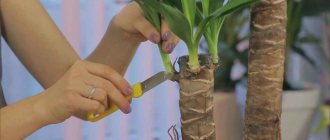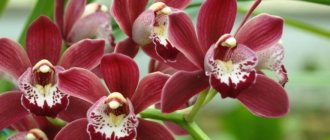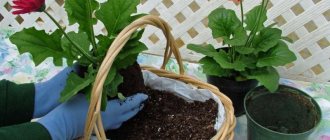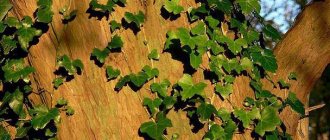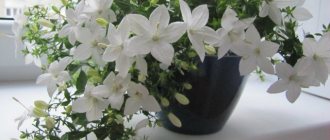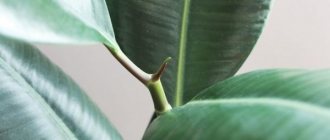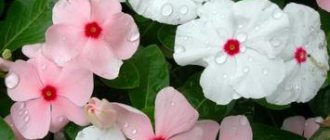Caring for garden evergreen ivy
It takes time to grow a strong and ornamental plant, as ivy grows slowly. For good growth, it must be provided with optimal conditions and proper care.
Watering
The first time after planting, regular watering is necessary. During the summer, watering is carried out based on the dryness of the soil and the condition of the foliage. In the absence of rain, ivy is watered 2 times a week, regularly, making sure that the water does not stagnate. Ivy responds well to sprinkling, since in this case the plant not only receives moisture, but also washes away dust from the leaves. In the fall, watering is reduced, and closer to winter it is stopped completely.
Loosening
Loosening is necessary to prevent the formation of a crust on the surface of the earth and to improve air access to the roots. When loosening, the lower shoots and adventitious roots should not be damaged.
Top dressing
Experienced gardeners recommend several feedings from March to August:
- Spring and the first half of summer - nitrogen fertilizers for the formation of shoots and foliage.
- Mid-summer and autumn - fertilizers with potassium and phosphorus or mineral mixtures for decorative deciduous crops for ripening of shoots.
When feeding, the doses of fertilizers applied should be strictly maintained, since when “overfeeding” the vine loses its decorative appearance.
Trimming
The first sanitary pruning is carried out in June after the end of sap flow in the spring. First of all, branches that are frozen and weakened after wintering are removed. Cuts on thick vines are treated with garden varnish.
In summer, decorative pruning is necessary, which allows you to timely direct the growing shoots of ivy in the right directions.
Ivy is often infested with mites, which can cause allergies, so before pruning it is necessary to hose down the ivy and wear a respirator.
Preparing ivy for winter
In regions with cold climates, ivy freezes without shelter, so the vines must be removed from their supports and laid on the ground
For covering, burlap and spruce branches are used; covering the root collar is especially important. Then the vine is covered with snow 10-15 cm thick
With the onset of spring, the shelter is removed and the leaves are removed by hand. Ivy does not tolerate “combing” with a rake.
Evergreen garden ivy will improve any area, create an original design and atmosphere, without requiring much expense, effort and time.
Cuttings are the main method of ivy propagation
Ivy branches take root so easily that when grown indoors, cuttings are often rooted simply in water. For garden ivy, in most cases, more traditional methods are used, but it is precisely because of the ease of rooting that cuttings are the main method. The vines take root within a few weeks, and the plants develop quickly.
For cuttings from ivy, it is best to use one-year-old young shoots. Both apical and stem cuttings are suitable. The apical cuttings should not be too small: the tops of branches 10 to 20 cm long are cut at an angle (between leaf nodes). The lower two pairs of leaves are removed from the cuttings. When using stem petioles, the entire shoot is separated. For this cutting method, young branches with 8-10 leaves are used.
You can root ivy cuttings:
- in water or solution of rooting stimulants;
- in a mixture of peat and sand;
- in a light substrate with a high sand content.
However, rooting in containers or containers is not the only option. Ivy can also be propagated in a greenhouse or mini-greenhouse in open soil.
Covering with a cap and greenhouse conditions for ivy are not at all necessary. As long as stable soil moisture is maintained, cuttings of this plant can be rooted without additional difficulties. Covering the container with a glass or film cap speeds up rooting, but nothing more. Any temperature is suitable for rooting cuttings: cuttings root in both warmth and heat, when the temperature exceeds 15-16 degrees. Treatment with growth stimulants can speed up the rooting process. But it is not considered a mandatory procedure.
The apical cuttings are planted in the soil, buried 1/3 of the height to the first node with leaves. On average, rooting in the substrate takes from 2 weeks to 1.5 months; after rooting, plants can be planted in a permanent place without growing in containers or seedling beds.
Stem cuttings are laid horizontally on the surface of the substrate, pressing the shoots to a depth of about 1.5 - 2 cm (or placing them in a groove) and leaving the leaves on the surface. You can immediately cut the stem into cuttings with one leaf node (about 10 cm long), but usually the shoot is left intact. Rooting occurs within 1 - 2 weeks, after which the tip of the shoot begins to grow. After signs of resumption of growth appear, there is no need to rush to cut the stem: the plants are separated only after 2 weeks. The stem is carefully removed from the substrate and cut into separate cuttings or independent plants, separating the rooted leaf nodes.
Rooted cuttings, especially stem ones, are rarely transferred immediately to a permanent place: they can be planted either in a container or in a separate bed for growing, simplifying the process of maintaining stable soil moisture. They are planted in a permanent location at the end of summer or early autumn, giving enough time for rooting before the arrival of winter and protecting them with mulching from severe frosts. But it’s better to wait until spring and grow ivy as a container crop or cover it in a garden bed, giving the plants more time to grow roots before the first wintering.
Reproduction of ivy by layering. © Jen
Useful properties of ivy
The plant has antibacterial, antifungal, anti-inflammatory effects. Used as an astringent, laxative, emetic, for polyps, sclerosis. An alcoholic extract from the fruit helps reduce blood pressure and is used to reduce warts and wen. Decoctions from the leaves are effective for coughs and headaches, and have a diaphoretic effect.
The hemolytic properties of ivy preparations make it possible to use it to maintain vascular tone. An infusion of ivy leaves is used for rheumatism, gout, joint arthritis and salt deposits. A decoction of the roots is used to treat boils and burns, and is used for scabies, lice, and mycoses of the scalp. Ivy is included in the collection of herbs for kidney and bladder stones. This is a very useful indoor plant - ivy purifies the air from formaldehyde, trichlorethylene, xylene, and benzene.
There are many medicinal folk remedies using this plant, although its fruits are considered poisonous, despite this, you should not be afraid of side effects in normal dosages.
Types of ivy for green fencing
Ivy is a woody evergreen vine. Among the many varieties, the garden variety of this plant grows and develops well in temperate climates. In landscape design, only two subspecies are used: ordinary and Colchis.
Ivy
Common ivy is characterized by moderate growth. But its foliage has special decorative properties. Shiny leaves can come in a variety of shapes. Therefore, it will not be difficult for any gardener, even the most demanding one, to choose a beautiful plant for his plot.
Colchis ivy grows very quickly. Its long shoots with large foliage will quickly weave the place prepared for this.
Colchis ivy
Both common ivy and Colchis ivy are blooming. However, their flowers are of no decorative value. But the inedible berries that appear after flowering add a special charm to the hedge.
Although all types of this plant prefer shaded areas, varieties with variegated leaves must receive enough sunlight, otherwise they will acquire a normal green color over time.
Replanting and pruning
As ivy grows and develops, it needs to be replanted. The plant is replanted for the first time a week to a week and a half after purchase. The pot for replanting should have drainage holes for excess water, and there should be a drainage layer of expanded clay at the bottom.
Note. The need for replanting is indicated by roots growing through the drainage holes.
It is advisable to replant young ivies every year.
From the age of three, the hedera is replanted every two years. After five years, the top soil layer is replaced. Transplantation is carried out in the warm season (from spring to autumn). Regular pruning of ivy is a necessary condition for caring for the plant. Shoots that have shed their leaves, old and diseased ones are trimmed, leaving at least two buds. They will grow up to be young.
Pruning promotes the growth of a lush crown and improves the decorative characteristics of the hedera. Despite the unkind popular rumor, many gardeners grow hedera in the house. The plant is as decorative as most house flowers, and care for indoor ivy is minimal.
Popular types and varieties
The plant is a heat-loving crop, so it is most often found in the south. Some frost-resistant vines grow in temperate climates. Here are the main types of ivy:
- ordinary. This is the most common plant that is used for planting outdoors and indoors. The leaves are medium-sized and have a five- or three-fingered shape. Depending on the variety, the foliage may have blotches or shine. Growth is moderate, reaching up to 20 m in length, weaving around nearby surfaces. Ivy is used for vertical gardening of structures and buildings. It is better to plant in partial shade. The most popular frost-resistant varieties are Goldhert, Mona Lisa, Eva, Sagittaefolia;
- Caucasian, or Colchian. This is a fast-growing plant species characterized by large dark green leaves and strong shoots. The liana is capable of weaving a surface up to 30 m high and grows in the shade. Popular garden forms - Dentata Variegata, Arborescens;
- Crimean. Ivy is unpretentious, grows quickly, and is resistant to cold and drought. As it grows, there is a lignification of the shoots that wrap around shrubs and trees. The length of an adult vine reaches up to 30 m, and the trunk in circumference is up to 1 m.
Each type has its own characteristics and features, but they are ideal for garden landscaping.
Ivy - can I keep it at home?
Properties of ivy
Ivy has long been known to mankind for its healing properties, used in folk medicine. Ivy is also used as a raw material for the manufacture of medicinal preparations and cosmetics. Scientists have proven that substances contained in the wood of the plant successfully relieve spasms, therefore preparations from wood are used in the treatment of acute bronchitis. And ivy leaves have antifungal, antitumor, antibacterial and expectorant properties. Softening gels from ivy leaves and wood are used as an additional remedy in the treatment of purulent dermatoses, obesity and cellulite.
However, be careful, because poison ivy, or rather its fruits, which children mistake for edible berries, cause poisoning.
Ivy - signs
The OBS agency (one grandmother said) claims that the indoor ivy flower is a muzhegon, an energy vampire, that it attracts loneliness and other misfortunes to the house, and if you don’t like this plant, you can convince yourself and others that you don’t want to keep ivy at home , because you love your husband and take care of your family. But historical documents claim that in the ancient world - Greece and Rome - ivy symbolized fidelity and happiness in marriage, and in the east it is still considered a source of vital energy. Which signs to believe, choose for yourself.
I would like to add that caring for home ivy is so simple, and its decorative qualities are so undeniably high, that it would be foolish to refuse to grow ivy in an apartment. In addition, ivy can be kept at home in a place where it will have no time to absorb your energy (if it does so at all) - for example, in the kitchen, where ivy will have to clean the air from carcinogens and other harmful impurities day and night.
Indoor ivy: care at home
Hedera (ivy) belongs to the Araliaceae family and is an evergreen climbing plant that in natural conditions can reach thirty meters in height. Today, there are about fifteen varieties of hedera ivy, growing in the subtropical zones of Africa, Asia, Europe, North and South America.
Since ancient times, ivy has been one of the most popular and beloved shrubs among gardeners. This is not surprising, because hedera looks equally beautiful both in hanging flower pots and in outdoor flowerpots, has a decorative appearance and is quite easy to propagate. English ivy looks especially gorgeous .
Common ivy is most often grown indoors, the species of which are distinguished by the variety of shapes and colors of foliage.
Diseases and pests of ivy
Common spider mite
Insects can be seen on the underside of young leaves or on the tips of shoots. The upper side of the affected leaves becomes covered with yellowish spots and dots, and with severe damage, a thin white cobweb forms between the leaves and stems. Damaged leaves become marbled, turn yellow and fall off prematurely.
Red spider mite
The mite bites into the skin of the stem, damaging it, leaving uneven gray-brown spots. It multiplies very quickly, actively affecting ivy.
Mealybug
Female scale insects lay eggs in white cotton wool-like fluffy secretions of leaves along the veins. Insects can secrete a sticky liquid - honeydew, on which a sooty fungus develops, polluting the plants. By sucking the juices of young shoots and leaves, scale insects greatly retard the growth of the plant.
Rooting cuttings of ivy
Like other vines, ivy can be easily propagated by layering. Scourges lying on the soil are capable of taking root themselves. But you can stimulate this process and get strong independent plants. The method of rooting cuttings is most popular when using ivy as a ground cover. But it is also suitable for those who need to get a not too large number of new plants.
There is nothing complicated in the process of rooting shoots:
- Strong, flexible ivy shoots from below (for those growing vertically) and along the perimeter (for ivy growing horizontally) are placed in a small trench. Usually, long, powerful shoots are chosen for rooting cuttings. Small cuts on the underside of the branches speed up rooting.
- The branches are secured in the soil with a staple and sprinkled with a nutrient substrate on top.
- Water thoroughly and then regularly water the soil to maintain stable moisture.
After the shoots have rooted, there is no need to rush to plant cuttings. In early autumn or next spring, young ivy is separated as independent bushes and planted in a permanent place.
If the ivy has long enough branches, then they can be fixed in the soil in waves, rooting several layers from one lash at a time.
